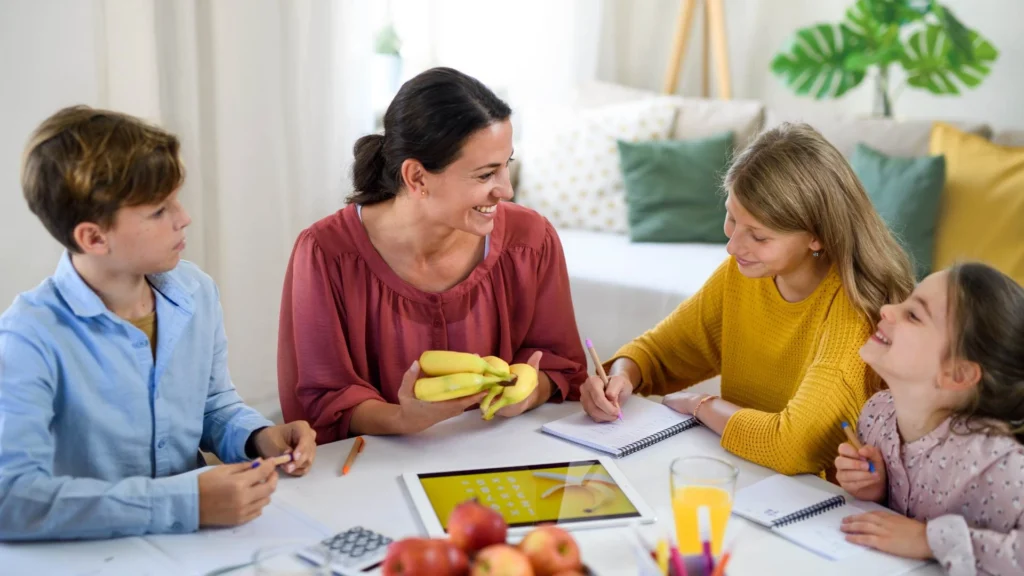Table of Contents
As parents, we want the best for our children, and that often means exposing them to a variety of activities. But with so many options — sports, arts, academics, and hobbies — how do we ensure our kids are getting the most out of their extracurriculars without overloading their schedules? The answer lies in skill stacking — an approach that focuses on combining activities that build multiple skills at once.
Instead of spreading your child’s time thin with dozens of separate activities, skill stacking enables them to gain more from each experience. By strategically pairing activities that complement each other, you maximize the time they spend learning, while also creating a balanced, well-rounded foundation.
In this blog, we’ll explore how skill stacking works, its benefits for kids’ development, and how you can choose the best activities that align with your child’s interests and growth. You’ll also learn practical ways to implement skill stacking into your child’s schedule, all while keeping things fun and manageable.
What is Skill Stacking?
Understanding Skill Stacking
Skill stacking is the practice of combining complementary skills so that learning in one area reinforces growth in another. Instead of taking separate classes for every skill a child needs to develop, skill stacking allows them to master multiple abilities through intertwined activities. It’s about creating a synergy where one skill feeds into the other, speeding up the learning process and building competence faster.
For instance, learning a musical instrument and reading sheet music at the same time teaches both cognitive and motor skills. The child is building not only musical talent but also enhancing their reading and pattern recognition abilities. This is an example of skill stacking in action. By stacking these skills, your child gets double the benefit from a single activity.
Why Skill Stacking is Effective for Kids
Skill stacking is especially effective for kids because it allows them to see connections between different fields. Instead of compartmentalizing their knowledge, children can integrate learning, making it easier to apply what they’ve learned in one context to another. For example, children who play a sport like soccer often see improvement in their problem-solving and critical thinking skills due to the strategic nature of the game. At the same time, they can transfer those teamwork skills into their academic or social life.
In the world of child development, integrating different types of learning accelerates overall growth. It fosters creativity, adaptability, and a deeper understanding of the world. By stacking skills through thoughtful activity choices, you’re helping your child develop a more versatile and adaptive mind.
Read: Save on Kids’ Activities: Swap Networks and Skill Shares
The Benefits of Skill Stacking for Kids
Builds Confidence and Resilience
When kids master more than one skill at a time, they experience a sense of accomplishment and increased self-esteem. Learning new things — especially in different areas — helps build their confidence and resilience. The more skills they acquire, the more they realize their own potential, which positively impacts their motivation to take on new challenges.
For example, when a child learns to juggle between sports practice, music lessons, and academic tasks, they build resilience in the face of challenge. These experiences help them realize that they are capable of balancing multiple demands, which boosts their confidence. The ability to manage different activities and grow in various domains also helps kids learn to cope with setbacks and develop a growth mindset.
Time Efficiency for Busy Schedules
With today’s packed schedules, time is often a major constraint. School, homework, extracurriculars, and social activities can leave little room for relaxation. That’s where skill stacking comes in — by carefully selecting activities that build multiple skills, you avoid spreading your child’s time too thin across unrelated hobbies.
When done right, skill stacking allows your child to make the most of their time. For example, enrolling them in a soccer class that also emphasizes communication, strategy, and leadership skills means they’re building a wide range of capabilities in one session. This efficient approach reduces the feeling of being overwhelmed by juggling too many commitments and ensures that every activity is both valuable and enriching.
Enhanced Creativity and Critical Thinking
Skill stacking is also a great way to nurture creativity and critical thinking in children. When kids are exposed to a variety of skills that intersect — like combining drama with problem-solving or painting with math — it helps them think outside the box. They learn that the same problem can be approached from different angles, leading to more creative solutions and better critical thinking abilities.
For instance, a child learning to design robots in a STEM program might also explore storytelling through digital media. This combination of technical and creative thinking enhances their ability to approach problems from multiple perspectives. The more interdisciplinary the activities, the better they are at seeing patterns, adapting to changes, and finding solutions.
How to Choose Activities for Skill Stacking?

Identify Your Child’s Core Strengths and Interests
Before you start stacking activities, it’s essential to understand your child’s core strengths and natural interests. What are they drawn to? Are they creative, athletic, or more academically inclined? The activities you choose should align with their interests, as they’ll be more motivated to engage in the process.
Identifying a child’s strengths gives you a clearer idea of which skill sets to build upon. For instance, if your child loves building things and is curious about how things work, a combination of engineering or robotics with art (e.g., building models) could be an excellent way to stack skills. If your child enjoys reading and storytelling, combining creative writing with drama or public speaking could foster their communication skills.
Focus on Complementary Skills
Once you’ve identified their strengths, choose activities that allow for skill overlap. For example, pairing an art class with a mathematics course may seem unrelated, but both disciplines involve creative problem-solving, spatial reasoning, and pattern recognition. Another great example is combining physical activities with cognitive challenges, such as pairing sports like soccer with strategic games or mental puzzles.
The goal is to pick activities that will reinforce each other. For example, learning to play an instrument not only builds musical skills but also enhances cognitive abilities like focus, memory, and listening skills. Combining activities like this allows for multiple benefits to build on one another, enabling children to grow in various areas with less time spent.
Consider Lifelong Skills
It’s important to consider activities that teach skills that children will use throughout their lives. Beyond the academic and extracurricular skills, it’s crucial to give them tools that will benefit their personal growth. Skills such as time management, teamwork, problem-solving, and communication are invaluable throughout adulthood and often stem from early activity choices.
For instance, teaching children the value of teamwork through sports or group-based activities can later translate into workplace skills like collaboration and conflict resolution. Similarly, activities like volunteering, public speaking, and debate will help them build leadership skills. The activities should lay the foundation for values and capabilities that will serve your child well in the future.
Read related blog: Teaching Kids Generosity—Smart Ways to Use Beem Pass for Family Finance
Examples of Skill Stacking in Kids’ Activities
Sports and Cognitive Skills
Sports offer the perfect environment for developing both physical and mental skills simultaneously. In games like basketball, soccer, or tennis, children not only develop physical agility and coordination but also learn about strategy, quick decision-making, and teamwork. These skills transfer directly to other areas of life, including academics and social interactions.
For example, a child who participates in basketball will need to make quick decisions under pressure, strategize with teammates, and focus on objectives — all valuable skills in any problem-solving scenario. Additionally, sports encourage resilience as children learn how to handle victories and setbacks in a supportive environment. Combining sports with academic pursuits, like math or science clubs, reinforces the development of both mental and physical abilities.
Arts and Cognitive Development
Engaging in arts-based activities such as learning to play a musical instrument, painting, or theater helps children develop creativity, emotional expression, and fine motor skills. When combined with other activities like math or reading, it promotes well-rounded cognitive development. For instance, learning how to read music requires both math (timing, rhythm) and logic (understanding notation), making it an excellent skill stack that enhances multiple capabilities simultaneously.
Additionally, arts-based activities often encourage children to think critically and express their thoughts and emotions in a healthy way. Skills gained in art classes — such as attention to detail, patience, and spatial reasoning — also transfer to academic learning, especially in subjects like geometry or problem-solving.
STEM and Social Skills
STEM (Science, Technology, Engineering, and Math) activities like coding, robotics, and environmental science provide critical thinking and problem-solving skills that are useful across many areas. But when combined with social-oriented activities, such as group projects, science fairs, or teamwork-based tasks, children also develop strong interpersonal skills, empathy, and communication abilities.
For instance, participating in a group coding project for a school competition allows kids to develop technical skills while learning to work collaboratively, manage time, and support each other. This not only improves their STEM proficiency but also fosters the soft skills that are equally important in both personal and professional settings.
How to Balance Skill Stacking with Play
Why Unstructured Playtime Still Matters
While skill stacking is effective for learning, it’s essential to remember the value of unstructured playtime. Play is how children explore, express their creativity, and learn independence. If every minute of a child’s schedule is filled with structured activities, they miss out on the mental rest and freedom that play provides.
Unstructured playtime allows children to take the lead in exploring their interests, experimenting with new ideas, and simply enjoying the moment. This is crucial for cognitive development and emotional well-being. So, while skill stacking is a great strategy, it should never replace the joy and learning that comes from free, unplanned play.
Setting Boundaries to Avoid Over-Scheduling
Over-scheduling children is a common mistake that can lead to stress, burnout, and a loss of enthusiasm for activities. While it’s important to stack skills, it’s equally crucial to avoid pushing your child too hard. Regularly evaluate whether your child is enjoying their activities or if they’re feeling pressured to succeed.
Setting healthy boundaries around activities ensures that kids still have time to relax, unwind, and recharge. It also helps foster a balanced approach to learning, where they can enjoy the benefits of skill stacking without sacrificing their well-being or social lives.
Check this out: How to Spend on Kids Without Spoiling Them?
Real-Life Examples of Successful Skill Stacking
Example – The All-Rounder Student Athlete
A 12-year-old child plays soccer and participates in a math tutoring group. Through soccer, they build teamwork, decision-making, and leadership skills. The math tutoring group reinforces these skills with problem-solving tasks. By stacking the two activities, they gain physical agility and enhanced academic performance, while also learning how to balance both.
Example – The Aspiring Artist with STEM Interests
A 9-year-old child takes both art lessons and coding workshops. Art helps them with creativity, fine motor skills, and patience, while coding develops problem-solving skills. Together, they offer a well-rounded skill set that promotes both creative and analytical thinking.
Example – The Social Science Enthusiast with a Love for Debate
A teenager interested in history joins a debate club. By discussing social, political, and historical issues in debates, they build critical thinking, research, and public speaking skills. These abilities transfer directly to their academic studies and future career goals, creating a powerful skill stack.
Common Mistakes People Make
Setting Unrealistic Caps
While stacking skills is great, it’s important not to overdo it. Setting caps on the number of activities ensures kids aren’t overwhelmed. Over-scheduling leads to exhaustion and burnout, which can make kids disengage from all their activities.
Ignoring the Recipient’s Preferences
Not all skills are beneficial for every child. It’s important to listen to their interests and find ways to match skill stacking to their natural curiosities and strengths. Forcing them into an activity they don’t enjoy can have the opposite effect, dampening motivation and creativity.
Forgetting to Budget Ahead
Managing skill stacking requires a clear budget. Without proper planning, you could end up spending more on extracurriculars than you intended. Setting up a Beem Budget Planner fund for activities ensures you’re saving and tracking expenses for these enriching experiences.
FAQs on Skill Stacking for Kids
1. How do I know if skill stacking is right for my child?
Look for activities that naturally align with your child’s interests. If they’re already engaged in one area, stacking it with a complementary skill can make learning easier and more enjoyable. For example, if they love art, combining it with a math activity can strengthen both their creativity and logical thinking.
2. Can skill stacking be applied to extracurricular activities other than sports or arts?
Yes, skill stacking can apply to any extracurricular, including academic pursuits, social activities, and hobbies. Think about activities that share overlapping skills, such as leadership and public speaking in debate or community volunteering, which can stack with problem-solving or social awareness.
3. How do I ensure my child isn’t overburdened with too many activities?
Create a schedule that includes time for both structured activities and unstructured play. It’s important to balance the benefits of skill stacking with the need for rest. Checking in with your child regularly about how they feel about their activities can also prevent burnout.
4. What’s the best way to start skill stacking with a younger child?
Begin with their current interests. If your child enjoys reading, try adding an activity like storytelling or drama to enhance their communication skills. If they’re into sports, try combining it with strategy games like chess or puzzles to boost cognitive skills.
5. How can Beem help me budget for my child’s skill-building activities?
Beem’s Budget Planner helps you allocate funds specifically for your child’s extracurriculars. By setting aside a portion of your budget for activities, you can make skill stacking an intentional, manageable part of your financial plan.
Conclusion
Skill stacking provides an efficient, fun, and impactful way for children to develop multiple skills at once. By combining complementary activities, you give them the tools to grow cognitively and emotionally while making the most of their limited time.
The key is to start with your child’s natural strengths and interests, prioritize experiences that build overlapping skills, and balance activities to avoid overwhelm. With careful planning and a little creativity, you can help your child build a well-rounded skill set that benefits them for years to come.
With Beem, skill stacking becomes easier to manage financially. Features like instant cash access, a secure smart wallet, the Beem Card for spending and credit building, and a personal AI assistant help you plan and track spending on activities, ensuring your child’s growth aligns with your family budget.
Download the Beem app today to make skill stacking a fun, sustainable, and financially smart journey for your child and family.















































